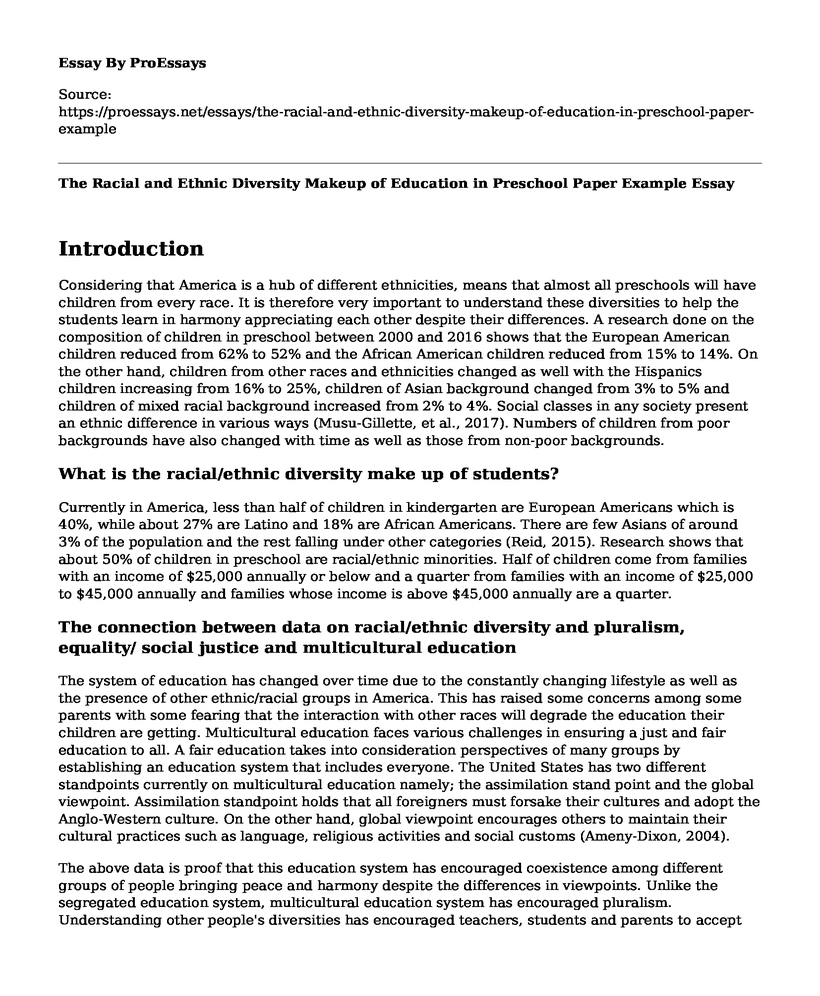Introduction
Considering that America is a hub of different ethnicities, means that almost all preschools will have children from every race. It is therefore very important to understand these diversities to help the students learn in harmony appreciating each other despite their differences. A research done on the composition of children in preschool between 2000 and 2016 shows that the European American children reduced from 62% to 52% and the African American children reduced from 15% to 14%. On the other hand, children from other races and ethnicities changed as well with the Hispanics children increasing from 16% to 25%, children of Asian background changed from 3% to 5% and children of mixed racial background increased from 2% to 4%. Social classes in any society present an ethnic difference in various ways (Musu-Gillette, et al., 2017). Numbers of children from poor backgrounds have also changed with time as well as those from non-poor backgrounds.
What is the racial/ethnic diversity make up of students?
Currently in America, less than half of children in kindergarten are European Americans which is 40%, while about 27% are Latino and 18% are African Americans. There are few Asians of around 3% of the population and the rest falling under other categories (Reid, 2015). Research shows that about 50% of children in preschool are racial/ethnic minorities. Half of children come from families with an income of $25,000 annually or below and a quarter from families with an income of $25,000 to $45,000 annually and families whose income is above $45,000 annually are a quarter.
The connection between data on racial/ethnic diversity and pluralism, equality/ social justice and multicultural education
The system of education has changed over time due to the constantly changing lifestyle as well as the presence of other ethnic/racial groups in America. This has raised some concerns among some parents with some fearing that the interaction with other races will degrade the education their children are getting. Multicultural education faces various challenges in ensuring a just and fair education to all. A fair education takes into consideration perspectives of many groups by establishing an education system that includes everyone. The United States has two different standpoints currently on multicultural education namely; the assimilation stand point and the global viewpoint. Assimilation standpoint holds that all foreigners must forsake their cultures and adopt the Anglo-Western culture. On the other hand, global viewpoint encourages others to maintain their cultural practices such as language, religious activities and social customs (Ameny-Dixon, 2004).
The above data is proof that this education system has encouraged coexistence among different groups of people bringing peace and harmony despite the differences in viewpoints. Unlike the segregated education system, multicultural education system has encouraged pluralism. Understanding other people's diversities has encouraged teachers, students and parents to accept each other despite their ethnicity differences.
Experts believe that multiethnic education which has its concepts anchored on liberty, justice, equality, and human dignity. This helps students prepare responsibly for a world of interdependency by accepting cultural differences and affirming pluralism that different people reflect (Gollnick Donna, Chinn, & Philip, 2013). It also helps students gain a higher level of education by developing a positive self-image through provision of knowledge about various histories. Through multicultural education human dignity and justice have been enhanced by ensuring that all students get equal opportunities in education.
References
Ameny-Dixon, G. M. (2004). Why multicultural education is more important in higher education now than ever: A global perspective. International Journal of Scholarly Academic Intellectual Diversity, 1-9. Retrieved from http://www.nationalforum.com/Electronic%20Journal%20Volumes/Ameny-Dixon,%20Gloria%20M.%20Why%20Multicultural%20Education%20is%20More%20Important%20in%20Higher%20Education%20Now%20than%20Ever.pdf
Gollnick Donna, M., Chinn, C., & Philip. (2013). Multicultural education in a pluralistic society. London: Pearson Higher Ed.
Musu-Gillette, L., Brey, C. d., McFarland, J., Hussar, W., Sonnenberg, W., & Wilkinson-Flicker, S. (2017). Status and Trends in the Education. Institute of Education Sciences, U.S. Department of Education. Washington: National Center for Education Statistics. Retrieved from https://nces.ed.gov/pubs2017/2017051.pdf
Reid, J. L. (2015). The Racial and Ethnic Composition of PreKindergarten Classrooms and Children's. Penn St. L. Rev, 119(3), 645- 655. Retrieved from http://www.pennstatelawreview.org/wp-content/uploads/2015/11/Reid-to-Print-edits-1.pdf
Cite this page
The Racial and Ethnic Diversity Makeup of Education in Preschool Paper Example. (2022, Nov 20). Retrieved from https://proessays.net/essays/the-racial-and-ethnic-diversity-makeup-of-education-in-preschool-paper-example
If you are the original author of this essay and no longer wish to have it published on the ProEssays website, please click below to request its removal:
- Teaching Methods for English as a Second Language Students
- Assessments on Learning of Students With Low Functioning Autism
- Research Proposal: Social Media and Its Positive Impact in the Contemporary Society
- Psychology and Economics in the Hispanic Population Essay
- Essay Sample on Effective Communication Skills: An Essential Requirement for Job Interviews
- Marketing Communication Strategy: Upscaling Skin Foundation Sales - Essay Sample
- Essay Example on Teen Magazines: Keeping Teens in the Know!







